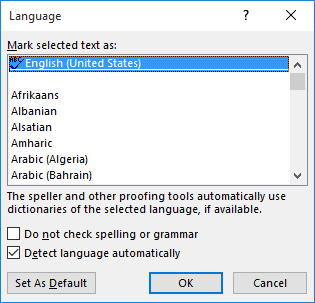Written by Allen Wyatt (last updated August 5, 2023)
This tip applies to Word 2007, 2010, 2013, 2016, 2019, 2021, and Word in Microsoft 365
Carol's company name uses a hyphen and she replaces it with a non-breaking hyphen. For instance, the name J-Team uses a non-breaking hyphen so that Carol doesn't get a J- on one line and the rest on the next. However, Word shows the hyphen and Team as misspelled. Carol wonders if there is a way to get Word to accept J-Team in the spell-check dictionary and stop flagging it. As it now stands, Word requires Carol to "ignore once" each time, as it won't even ignore all.
In doing testing, I was unable to recreate this problem. I tried using "J-Team" and "Smith-Johnson," both with regular hyphens and non-breaking hyphens. In all instances, on all versions of Word, the hyphenated words were not marked as incorrect spellings.
That being said, it could be that the problem isn't with the spell checker but with the grammar checker. (You can tell if Word uses a green squiggly underline under the term instead of a red squiggly underline.) If this is the case, you can follow these steps:

Figure 1. The Grammar Settings dialog box.
If the problem is that Word actually flags the term as a spelling error (there is a red squiggly line under part or all of the term), then that is a bit more problematic. The first thing to do is to check to see that you are actually using a non-breaking hyphen between the words. If, instead, you are using an optional hyphen, then the entire term will be marked as spelled wrong. You should be using a non-breaking hyphen, entered by pressing Ctrl+Shift+Hyphen.
You'll also want to check to make sure that the words (or, indeed, any part of the hyphenated term) are not formatted for a foreign language. Select the entire hyphenated term, and then display the Review tab of the ribbon. If you're using Word 2007, click the Set Language tool in the Proofing group. In Word 2010 and later versions, click Language in the Language group and select Set Proofing Language from the resulting drop-down menu. Word displays the Language dialog box. (See Figure 2.)

Figure 2. The Language dialog box.
If the top of the dialog box does not have a single language selected, it means that the hyphenated term is formatted to use multiple languages. Make sure that you select which language you want applied to the entire term, and then click OK.
When it comes to spelling errors in this case, what you can't do is to try to enter the term into the dictionary; it won't work. Why? Because the dictionary deals with single words, not with compound words. While you can enter the entire compound term into the custom dictionary, Word will still continue marking the spelling as incorrect if it did so before.
WordTips is your source for cost-effective Microsoft Word training. (Microsoft Word is the most popular word processing software in the world.) This tip (13473) applies to Microsoft Word 2007, 2010, 2013, 2016, 2019, 2021, and Word in Microsoft 365.

Do More in Less Time! An easy-to-understand guide to the more advanced features available in the Microsoft 365 version of Word. Enhance the quality of your documents and boost productivity in any field with this in-depth resource. Complete your Word-related tasks more efficiently as you unlock lesser-known tools and learn to quickly access the features you need. Check out Microsoft 365 Word For Professionals For Dummies today!
As you type, Word is busy working in the background to determine if there are spelling and grammar errors in your prose. ...
Discover MoreAre you creating a document that mixes different languages? Word can handle the multi-language scenario, but it may take ...
Discover MoreWord keeps track of the words that may be misspelled in a document. If you are working with a lot of documents, you may ...
Discover MoreFREE SERVICE: Get tips like this every week in WordTips, a free productivity newsletter. Enter your address and click "Subscribe."
There are currently no comments for this tip. (Be the first to leave your comment—just use the simple form above!)
Got a version of Word that uses the ribbon interface (Word 2007 or later)? This site is for you! If you use an earlier version of Word, visit our WordTips site focusing on the menu interface.
Visit the WordTips channel on YouTube
FREE SERVICE: Get tips like this every week in WordTips, a free productivity newsletter. Enter your address and click "Subscribe."
Copyright © 2025 Sharon Parq Associates, Inc.
Comments